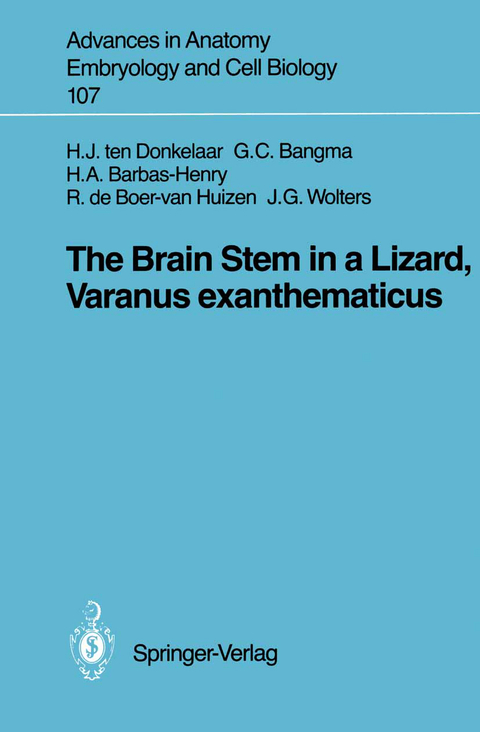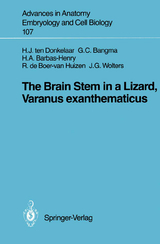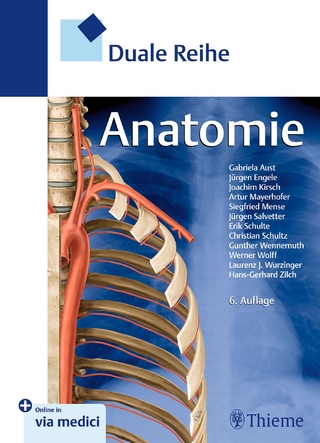The Brain Stem in a Lizard, Varanus exanthematicus
Springer Berlin (Verlag)
978-3-540-17948-1 (ISBN)
1 Introduction.- 2 Materials and Techniques.- 2.1 Cytoarchitectonic Analysis.- 2.2 Immunohistochemical Procedures.- 2.3 Tract-Tracing Studies.- 3 Gross Anatomy.- 3.1 The Brain Stem.- 3.2 The Cranial Nerves.- 4 Spinal Projections to the Brain Stem.- 4.1 The Dorsal Column Nucleus and its Afferent and Efferent Connections.- 4.2 Fiber Systems Ascending in the Lateral Funiculus.- 5 Organization and Connections of the Sensory Trigeminal Nuclei.- 5.1 Cytoarchitecture.- 5.2 Primary Afferents.- 5.3 Central Trigeminal Projections.- 6 The Solitary Tract and Related Nuclei.- 6.1 Cytoarchitecture : Viscerosensory Nuclei.- 6.2 Primary Afferents.- 6.3 Central Visceral and Taste Pathways.- 7 Cranial Nerve Motor Nuclei.- 7.1 Somatomotor Nuclei.- 7.2 Branchiomotor Nuclei.- 7.3 Visceromotor Nuclei.- 8 The Vestibular Nuclear Complex and Related Structures.- 8.1 Cytoarchitecture.- 8.2 Primary Afferents.- 8.3 Central Vestibular Projections.- 9 Acoustic Projections.- 9.1 Primary Acoustic Projections and Nuclei.- 9.2 The Superior Olive.- 9.3 The Torus Semicircularis.- 10 Visual Input to the Brain Stem.- 10.1 The Tectum Mesencephali.- 10.2 The Nucleus of the Basal Optic Root.- 10.3 The Isthmic Nuclei.- 11 Forebrain Projections to the Brain Stem.- 11.1 Notes on the Organization of the Reptilian Forebrain.- 11.2 Basal Ganglia Projections to the Brain Stem.- 11.3 Diencephalic Projections to the Brain Stem.- 11.4 The Habenulointerpeduncular Tract.- 12 Cerebellar Connections.- 12.1 Notes on the Cerebellar Cortex.- 12.2 The Cerebellar Nuclei.- 12.3 Afferent Connections of the Cerebellum.- 12.4 Efferent Connections of the Cerebellum.- 13 The Reticular Formation.- 13.1 Cytoarchitecture.- 13.2 Monoaminergic and Peptidergic Components.- 13.3 Ascending Projections.- 13.4 Descending Projections.- 14 Concluding Remarks.- 14.1 Ascending Projections.- 14.2 Descending Projections to the Brain Stem.- 14.3 Descending Projections from the Brain Stem.- 14.4 Cerebellar Connections.- 14.5 Research Perspectives.- Acknowledgments.- References.
| Erscheint lt. Verlag | 18.8.1987 |
|---|---|
| Reihe/Serie | Advances in Anatomy, Embryology and Cell Biology |
| Zusatzinfo | XIII, 168 p. 37 illus. |
| Verlagsort | Berlin |
| Sprache | englisch |
| Maße | 170 x 244 mm |
| Gewicht | 400 g |
| Themenwelt | Studium ► 1. Studienabschnitt (Vorklinik) ► Anatomie / Neuroanatomie |
| Naturwissenschaften ► Biologie ► Zoologie | |
| Schlagworte | brain • Cell • Cortex • Reptiles • Vertebrates |
| ISBN-10 | 3-540-17948-8 / 3540179488 |
| ISBN-13 | 978-3-540-17948-1 / 9783540179481 |
| Zustand | Neuware |
| Informationen gemäß Produktsicherheitsverordnung (GPSR) | |
| Haben Sie eine Frage zum Produkt? |
aus dem Bereich




